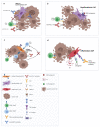Cancer-associated fibroblasts in the single-cell era
- PMID: 35883004
- PMCID: PMC7613625
- DOI: 10.1038/s43018-022-00411-z
Cancer-associated fibroblasts in the single-cell era
Abstract
Cancer-associated fibroblasts (CAFs) are central players in the microenvironment of solid tumors, affecting cancer progression and metastasis. CAFs have diverse phenotypes, origins and functions and consist of distinct subpopulations. Recent progress in single-cell RNA-sequencing technologies has enabled detailed characterization of the complexity and heterogeneity of CAF subpopulations in multiple tumor types. In this Review, we discuss the current understanding of CAF subsets and functions as elucidated by single-cell technologies, their functional plasticity, and their emergent shared and organ-specific features that could potentially be harnessed to design better therapeutic strategies for cancer.
© 2022. Springer Nature America, Inc.
Conflict of interest statement
The authors declare no competing interests.
Figures





References
Publication types
MeSH terms
Grants and funding
LinkOut - more resources
Full Text Sources
Other Literature Sources
Medical

